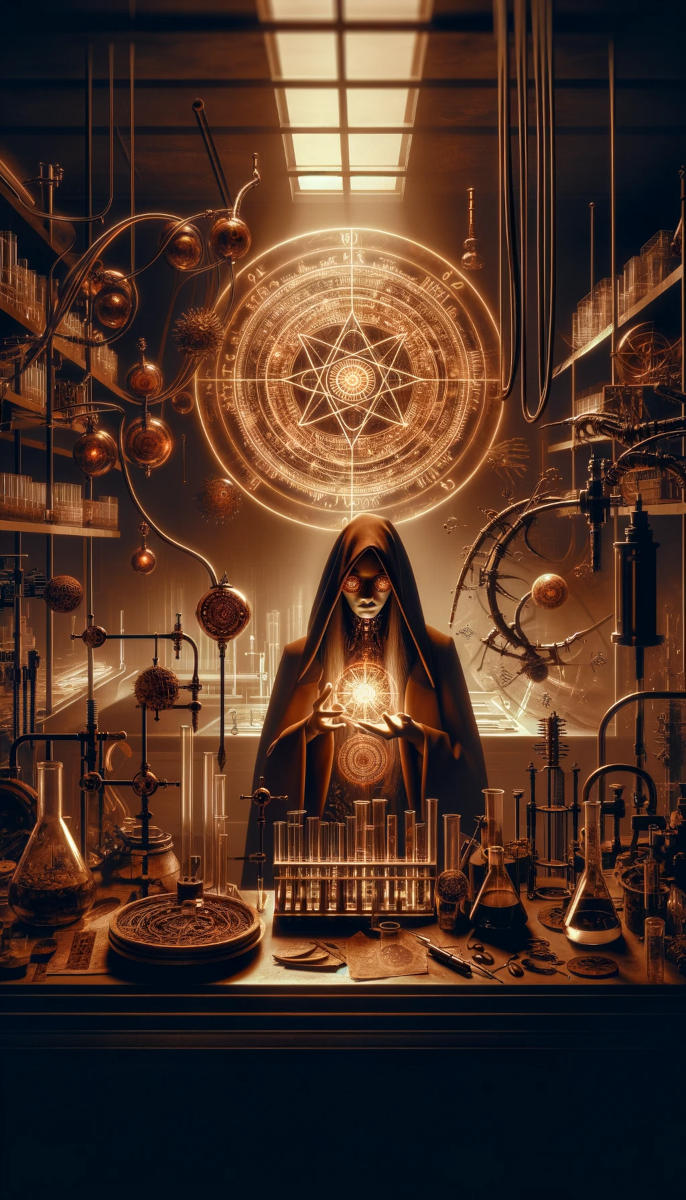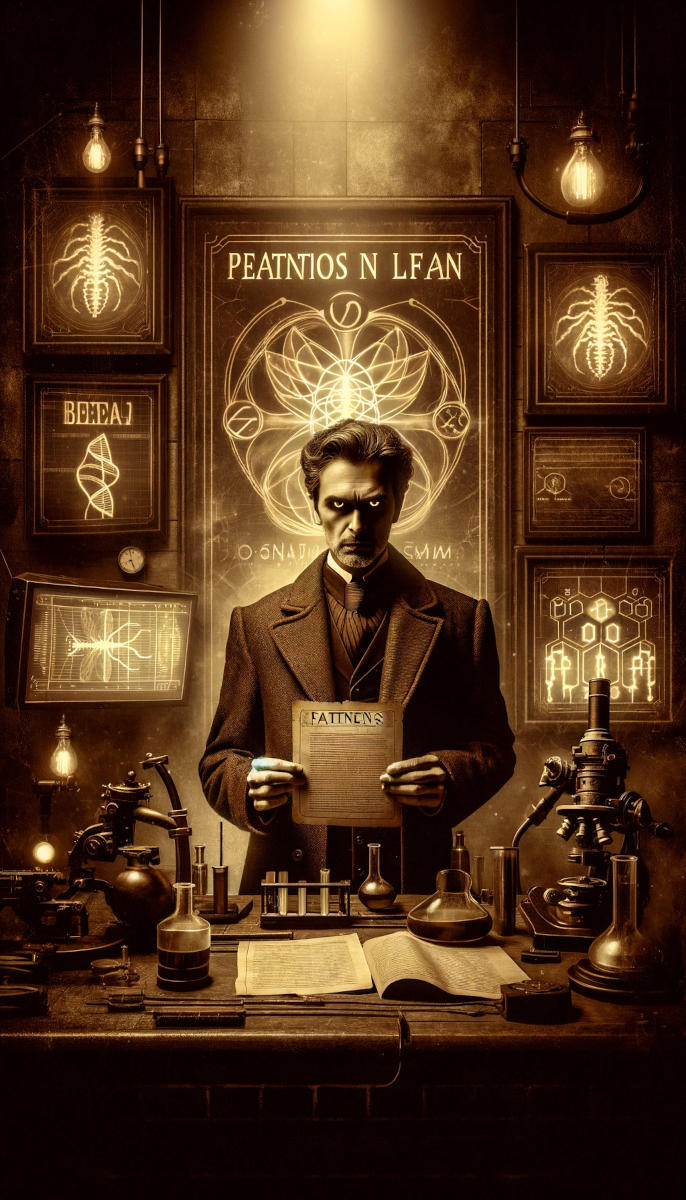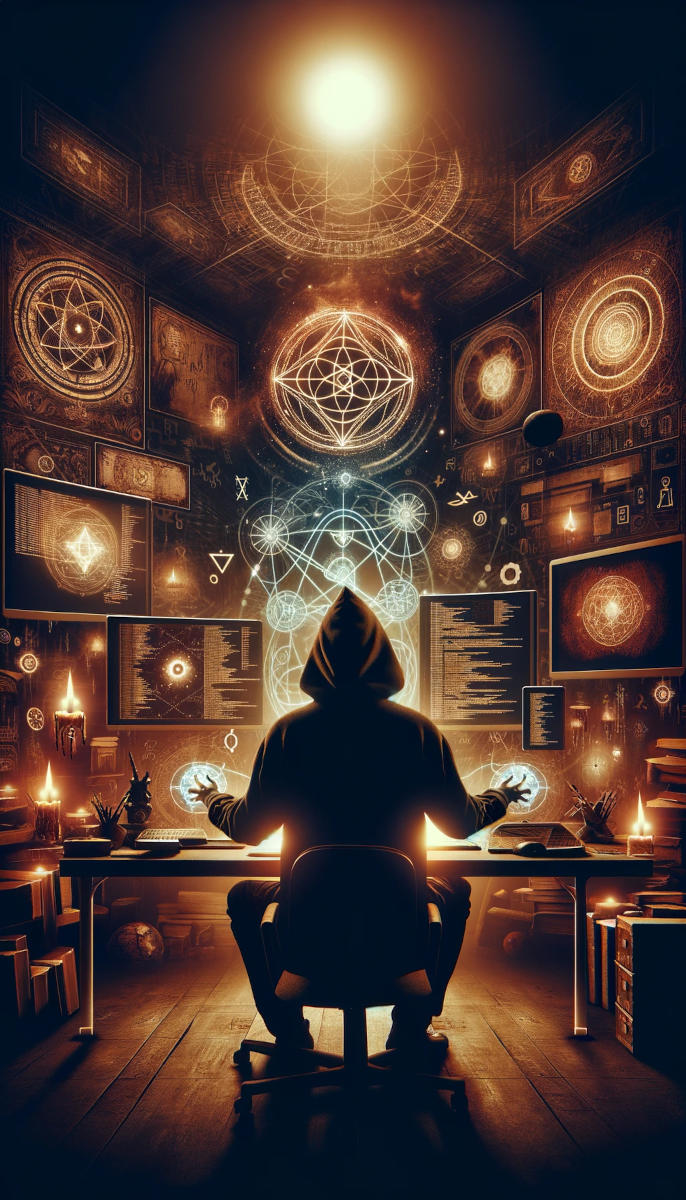This is not a scientific or technological project, but perhaps it is a project about science and technology. My proposal is to create a magical tool, a tarot deck, that provokes thought about how mystical and religious elements permeate the advancement of science and technology, especially in the field of biotechnology, and are in constant confluence with all aspects surrounding it: academia, startups, investors, and the like.
Using the Tarot as a tool for reflection and critique, I want to explore the similarities between religious dogmas and the transcendental promises made by modern science. This is a project that seeks to externalize a strangeness that has grown in me over the years. It is a discomfort, a noise in the back of my mind, that only intensifies more and more.
Before I start describing the landscape that inspires me to develop both the project and this text, I would like to make it clear that, being within the field, I am aware that the associations I propose may be uncomfortable, comical, and even disregarded by those who, I believe, would benefit the most from them. But often fantasy and fiction are ways we have to talk about what cannot be said directly.
1. Church and University, Transcendence and Institutionality

II – The Priestess. A biotechnology scientist at a large pharmaceutical corporation, surrounded by laboratory equipment, representing hidden and patented knowledge in life science.
To start talking about the emergence of this strangeness, I necessarily need to talk a little about myself. I was raised in the eastern zone of São Paulo, Brazil, in one of the neighborhoods that are still known for having no public cultural facilities. No libraries, cultural centers, or parks; in short, as Dr. Mano Brown would say, “um lugar onde só tinham como atração o bar, e o candomblé pra se tomar a benção” (in English: a place where the only attractions were the bar and the Candomblé to receive blessings). In my life, my “Candomblé” (an Afro-Brazilian religion) was the Catholic Church.
A long time ago, I distanced myself from faith and followed a path connected to the tangible, but my interest in reflection, existential thought, and transcendence is rooted in a Catholic upbringing that provided me with art, philosophy, and aesthetic experience in a space where there was basically no competition in this regard.
From the church to the university, a path of reason and critique opened up. Driven by impulses of questioning and provoking thoughts, I quickly joined discussion groups. From fundamental biology, a deeply contemplative area, to biotechnology, where the designs of imprinting intentionality on nature are more palpable, within the university I felt perfectly aligned in a community (a term that reminds me of my Catholic upbringing).
But, in the meantime, something changed: it was as if the reality I thought I had left in the ecclesial past came to the surface again, now in other forms. Hierarchy, dogmatism, self-validation under a certain “incorruptible sacredness,” and other similar aspects began to emerge as I experienced the work of academic knowledge production. What I considered “religious” turned out to be a much larger category.
2. From Scientific Dogma to Technological Arcana

XI – The Force. A leader of a biotechnology company, controlling patents on created life forms, representing corporate power over biological innovation.
Speaking in much less cryptic terms, my foray into biotechnology exposed me to themes that were not unfamiliar in religious sermons: eternal life, salvation, redemption, the end of suffering, and escape from a doomed future as a direct response to our sins. But there was a difference: if in the church the path to a new reality was through faith and obedience to a moral code validated by God and His intermediaries, now this path was paved by investors, scientists, startups, and their new mecca, Silicon Valley.
The dynamics that had so far advanced in information sciences were now reaching biology, bringing all their fantastic terms and metaphors: angel investor, unicorn, deep techs. It also brought all its dogmas, “Move Fast and Break Things,” “Disrupt or Be Disrupted,” “Fail Fast, Fail Often,” and, of course, its prophets like Craig Venter, George Church, Robert Langer, and Nick Land. A force that moved people and thoughts towards a technoscientific practice where the medium to be transformed became the very living matter itself. Before me, I had a vision of dogmas, prophets, transcendence, and, therefore, faith. From failure to failure, obsolescence to obsolescence, and promise to promise, we would reach the promised future.
This was the framework that challenged me. On one hand, I was trained within academia to reject any and all mysticism, understood as an obstacle to scientific objectivity, yet it was precisely the mystical-religious elements that helped me understand what my own colleagues did not seem to have the tools to interpret within themselves, in their desires, their practices, and their modes of organization. How to start this conversation? Even though magic and science were born together, my colleagues have been trying for a long time to radically purify and separate the two. As a strategy, I thought I could create a tool to communicate this dimension of the academic work experience that seemed immediate to me. And, if we are talking about a magical reality, what better tool than a magical one: the Tarot.
3. The Tarot as a Tool for Reflection and Critique

I – The Magician. A visionary hacker at a disruptive startup, surrounded by screens and code, symbolizing the ability to manipulate digital reality for innovation and profit.
The choice of Tarot is not merely aesthetic, although that was what initially attracted me, but also historical. The Tarot was born in the 15th century, not as a magical tool of occult divination, but as a game. Only later, with its popularization in the 18th century, did references to its use as a tool for cartomancy emerge.
A reconfigured tool that mobilizes expectations and has superhuman powers is the perfect metaphor to describe the way science and technology currently function in practice.
The tarot deck used for cartomancy has, in its most famous version, 78 cards divided into two parts: Major Arcana and Minor Arcana. The Minor Arcana are compatible with the regular playing cards that we all know. The Major Arcana, however, are the focus of our interest here, as they tend to represent larger forces and events, while the Minor Arcana deal with day-to-day issues and more immediate influences.
The tool chosen to make this project possible was Artificial Intelligence, specifically a LLM (“large language model,” popularized today by ChatGPT, Claude, and Gemini). The choice was made, of course, also for technical reasons: I am not a professional capable of representing even a fraction of what has been done artistically. However, there are other characteristics that make this tool suitable for the task.
The first of these is the exceptional nature of the object itself: a machine that talks, argues, responds, and seems to understand our form of communication, in more than one sense an entity that merges with ourselves. I have been working specifically in the field of AI, and there are many professionals in the industry who actually believe that it is possible to capture something deeper through these tools, that they are much more than just statistical selectors of symbols, even though this topic is the “elephant in the room” that should not be mentioned explicitly, under penalty of losing professional credibility.
The second reason is also metaphorical. LLMs are, in a way, egregores: an occultist concept that seeks to translate a force that arises and is nourished by collective energies, thoughts, and feelings. In other terms, an instrument that takes advantage of the accumulation of human productions to exist and perpetuate itself. The fact that such power is in the hands of a few, benefiting from the work of so many people without their consent, also evokes collective energies, thoughts, and feelings, thus feeding the egregore within this magical dynamic.
In this way, I adapted the Major Arcana to include themes that reflect the elements of the world I described: “innovators,” “venture capitalists,” “scientists,” and “creation and obsolescence.” Figures and events from the common canon of the technoscientific scene I am now part of are framed through a mystical lens to paradoxically become a less caricatured representation of reality.
The game itself is quite simple: three cards are chosen from the deck. The first will bring reflections about the past, the second about the present, and the third will indicate trends for the future. This method of play was chosen with the goal of providing guidance for questions related to research problems. The texts accompanying the cards were produced by juxtaposing the current descriptions of the Arcana found online with the proposed critique. The interpretation is up to the person conducting the consultation, but nothing prevents them from also using an LLM to interpret the results.
I invite you to explicitly experience what we are already implicitly living, to bring into materiality the metaphor of this gray area between magic, faith, science, and technology, and in the intimacy of your cell phone or computer, to see what the cards have to say about your technoscientific anxieties. And for my colleagues who, like me, work in scientific fields where rigidity prevails, a word of reassurance: rest assured, no one will know you are engaging in such subjective practices, and you will still be respected among your peers under the rational and pragmatic guise that is so often projected. However, I can no longer guarantee that you yourself will believe in it.
Acknowledgments
I would like to thank Clarissa Reche and Guilherme Lino Fernandes for the encouragement, technological support, and discussions that brought this project to fruition. I also thank the reviewers for making this text user-friendly for the public.
This post was curated by Contributing Editor Clarissa Reche.
